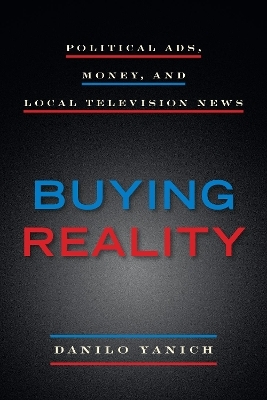
Buying Reality
Political Ads, Money, and Local Television News
Seiten
2020
Fordham University Press (Verlag)
978-0-8232-8895-3 (ISBN)
Fordham University Press (Verlag)
978-0-8232-8895-3 (ISBN)
From a certain perspective, the biggest political story of 2016 was how the candidate who bought three-quarters of the political ads lost to the one whose every provocative Tweet set the agenda for the day’s news coverage. With the arrival of bot farms, microtargeted Facebook ads, and Cambridge Analytica, isn’t the age of political ads on local TV coming to a close?
You might think. But you’d be wrong to the tune of $4.4 billion just in 2016. In U.S. elections, there’s a lot more at stake than the presidency. TV spending has gone up dramatically since 2006, for both presidential and down-ballot races for congressional seats, governorships, and state legislatures—and the 2020 campaign shows no signs of bucking this trend. When candidates don’t enjoy the name recognition and celebrity of the presidential contenders, it’s very much business as usual. They rely on the local TV newscasts, watched by 30 million people every day—not Tweets—to convey their messages to an audience more fragmented than ever.
At the same time, the nationalization of news and consolidation of local stations under juggernauts like Nexstar Media and Sinclair Broadcasting mean a decreasing share of time devoted to down-ballot politics—almost 90 percent of 2016’s local political stories focused on the presidential race. Without coverage of local issues and races, ad buys are the only chance most candidates have to get their messages in front of a broadcast audience.
On local TV news, political ads create the reality of local races—a reality that is not meant to inform voters but to persuade them. Voters are left to their own devices to fill in the space between what the ads say—the bought reality—and what political stories used to cover.
You might think. But you’d be wrong to the tune of $4.4 billion just in 2016. In U.S. elections, there’s a lot more at stake than the presidency. TV spending has gone up dramatically since 2006, for both presidential and down-ballot races for congressional seats, governorships, and state legislatures—and the 2020 campaign shows no signs of bucking this trend. When candidates don’t enjoy the name recognition and celebrity of the presidential contenders, it’s very much business as usual. They rely on the local TV newscasts, watched by 30 million people every day—not Tweets—to convey their messages to an audience more fragmented than ever.
At the same time, the nationalization of news and consolidation of local stations under juggernauts like Nexstar Media and Sinclair Broadcasting mean a decreasing share of time devoted to down-ballot politics—almost 90 percent of 2016’s local political stories focused on the presidential race. Without coverage of local issues and races, ad buys are the only chance most candidates have to get their messages in front of a broadcast audience.
On local TV news, political ads create the reality of local races—a reality that is not meant to inform voters but to persuade them. Voters are left to their own devices to fill in the space between what the ads say—the bought reality—and what political stories used to cover.
Danilo Yanich is a Professor of Urban Affairs and Public Policy at the Joseph R. Biden, Jr. School of Public Policy of the University of Delaware. He is the Associate Director of the school and directs the masters program in Urban Affairs and Public Policy. He is a two-time Presidential Fellow of the Salzburg Seminar; his research focuses on the relationship among the media, citizenship, and public policy.
Introduction | 1
1 Why Local Television News Matters | 19
2 A Brief History of Political Advertising | 39
3 Research Method and Market Profiles | 61
4 Political Ads | 75
5 Political Stories | 98
6 The Markets | 131
7 The Business of News | 174
Conclusion: Where Do We Go from Here? | 210
Acknowledgments | 227
Reference List | 231
Index | 253
| Erscheinungsdatum | 02.01.2020 |
|---|---|
| Reihe/Serie | Donald McGannon Communication Research Center's Everett C. Parker Book Series |
| Zusatzinfo | 50 |
| Verlagsort | New York |
| Sprache | englisch |
| Maße | 152 x 229 mm |
| Themenwelt | Sozialwissenschaften ► Kommunikation / Medien ► Journalistik |
| Sozialwissenschaften ► Kommunikation / Medien ► Medienwissenschaft | |
| Sozialwissenschaften ► Politik / Verwaltung ► Staat / Verwaltung | |
| Wirtschaft | |
| ISBN-10 | 0-8232-8895-1 / 0823288951 |
| ISBN-13 | 978-0-8232-8895-3 / 9780823288953 |
| Zustand | Neuware |
| Informationen gemäß Produktsicherheitsverordnung (GPSR) | |
| Haben Sie eine Frage zum Produkt? |
Mehr entdecken
aus dem Bereich
aus dem Bereich
Fachwissen für Netzpublikationen
Buch | Softcover (2024)
Herbert von Halem Verlag
39,00 €
zehn Szenarien für das nächste Jahrzehnt
Buch | Softcover (2025)
Springer Fachmedien Wiesbaden GmbH (Verlag)
17,99 €


